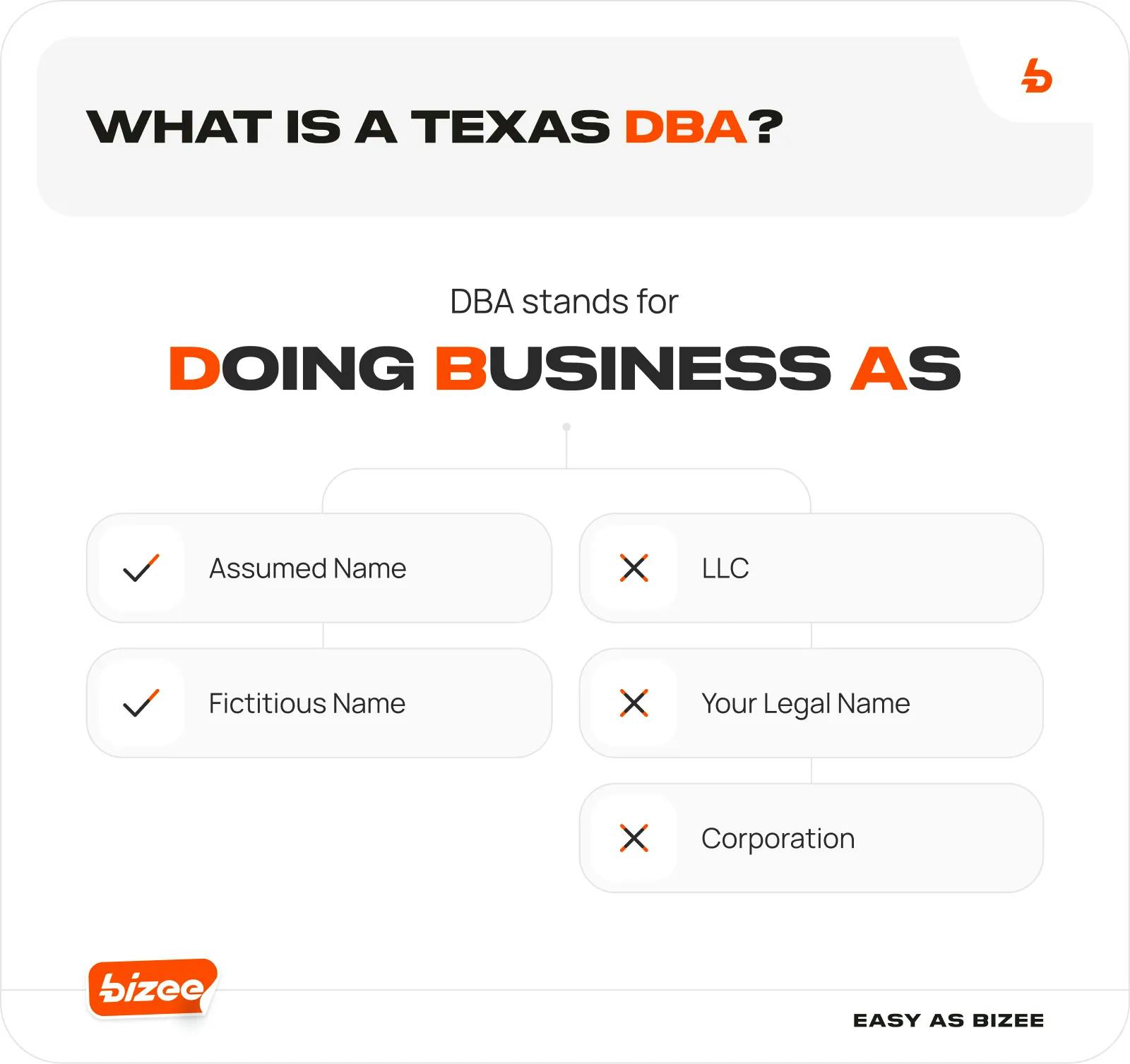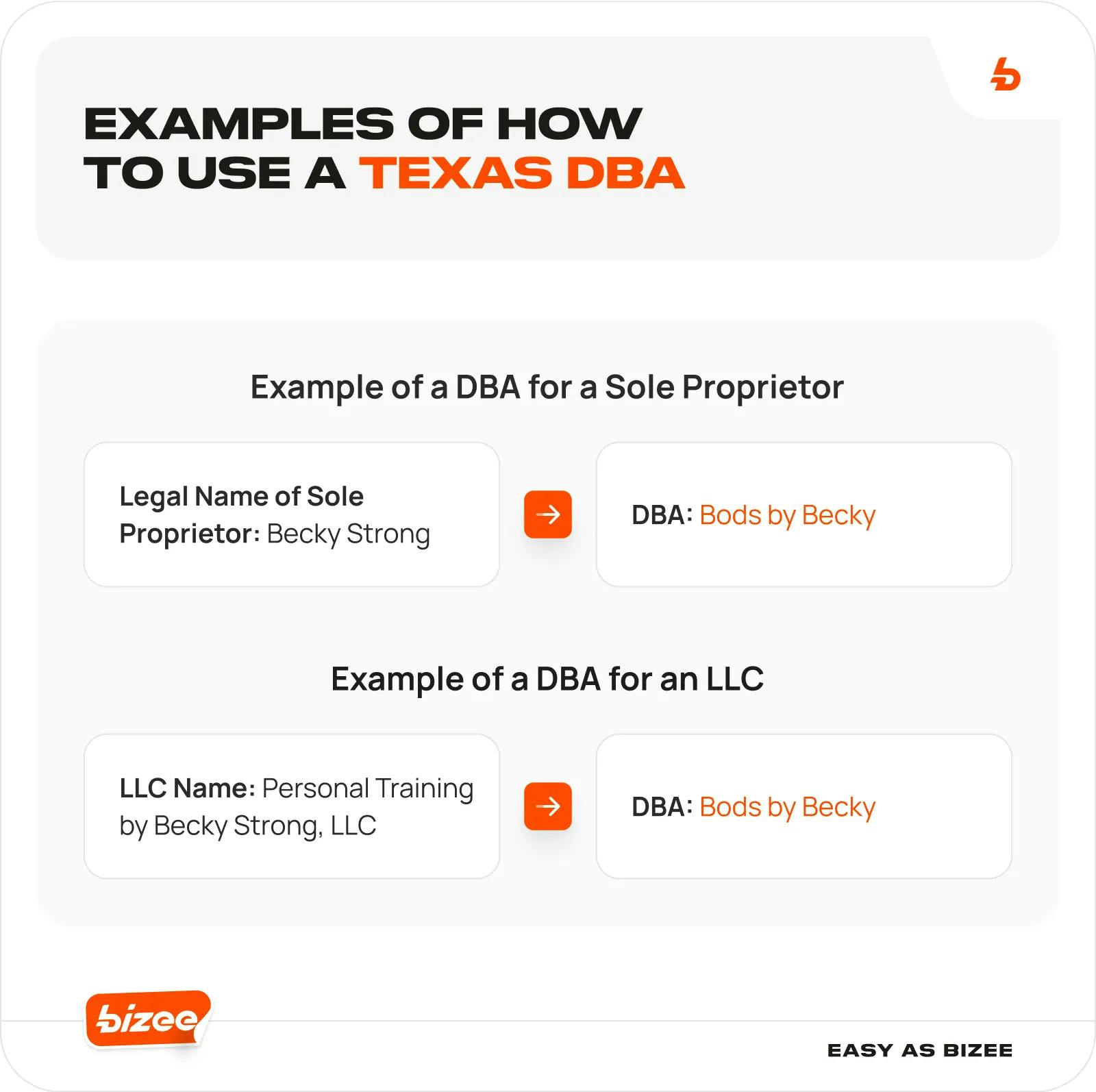Please note: This post contains affiliate links and we may receive a commission if you make a purchase using these links.
TABLE OF CONTENTS
While Texas is known for its simple business regulations, the state does have some unique forms, requirements and terminology for small business owners to navigate. If you’re starting or doing business in Texas, you might want to know more about how to file a Texas DBA. Here's every step of the process and everything you need to know about how to file a DBA in Texas.
What Is a Texas DBA?
The acronym DBA stands for Doing Business As. Your DBA is the name you will conduct your business under. A DBA is most often used if you would like to do business under a name that is different from your legal name. In Texas, a DBA is commonly referred to as an assumed name and the filing is referred to as an Assumed Name Certificate.
In Texas, a DBA is an official filing you will register for with the local, county and/or state government of Texas, depending on your business structure. Remember, your DBA will indicate the name your company, or you personally, are doing business as in Texas.

You can file a Texas DBA regardless of the type of business entity you have registered as, whether your business is operating as an LLC, corporation or even a sole proprietorship. However, a Texas DBA alone will not protect your personal assets or provide you with liability coverage.
Forms Needed to File a DBA in Texas
It is simple to register for your Texas DBA on the state’s online business services website, SOSDirect. You will have to log into the system to fill out your form electronically.
How to Register for Your Texas DBA Online
- Log in as a temporary user or as an SOSDirect account holder. To create a temporary login to fill out the form, go to the SOSDirect Account Login Screen and click on “temporary login form.” To create an account on SOSDirect, click “request for SOSDirect Account.”
- Enter payment information before you create an account.
- Once you are in your account, access the Assumed Name Certificate, Form 503.
- Pay the $25 filing fee using a LeagalEase debit card or a credit card. Credit cards will be subject to a 2.7 percent processing fee.
The SOSDirect site is a bit clunky to use and will require you to enter payment information upfront. In addition, the website automatically signs you out after 15 minutes of inactivity. If you are not comfortable with a computer, using a system like SOSDirect can be frustrating. You can also complete a paper filing for a DBA in Texas.
How to Register a Texas DBA on Paper
- To register a Texas DBA name with the Secretary of State on paper, fill out the Assumed Name Certificate application, form 503. You can find this form available as a Word document or a PDF on the SOSDirect Website list of forms. Scroll down to download the form, print it and then fill it out. The forms available through SOSDirect may also be filled out on your computer, then printed out.
- To mail the application, send it with a check or money order for the $25 fee to:
Secretary of State
P.O. Box 13697
Austin, TX 78711-3697
- To fax the application, send it to (512) 463-5709. Credit card information must be included if you’re filing by fax. Fill out Form 807 to pay the filing fee, plus a 2.7 percent convenience fee. American Express, Mastercard, Visa and Discover are all accepted.
- To register the application in person, deliver it to the:
James Earl Rudder Office Building
1019 Brazos St.
Austin, TX 78701
Payment can be made in person using a personal check, money order, LegalEase debit card or credit card.
Information Needed to Fill Out Your Assumed Name Certificate
Whether or not you file your Assumed Name Certificate online or on paper, you will need the following information to fill it out correctly:
- DBA or assumed name under which you plan to do business
- Legal name of your business
- Your business entity
- Your file number from the Secretary of State if you have one
- The state, country or jurisdiction where the entity was legally formed
- Your business office address
- Duration for the use of the assumed name (up to 10 years)
- County or counties where you’ll do business under the assumed name
How to File for a DBA in Texas as a Sole Proprietor
If you choose to do business as a sole proprietor, you will need to file your Texas DBA at the county level in addition to the state level. Remember, filing for a DBA will not protect you personally from liability. It will only allow you to do business under a name that is different from your legal name.
Before you decide on your DBA, you will want to search to see if an entity name is available in the state of Texas. This can be done through the Texas Comptroller’s Name Database, but keep in mind there is a $1 fee for each search conducted. If you would like to do further research, check with the United States Patent and Trademark Office. You can also use Bizee’s free Business Name Search database.
You want to make sure you are not choosing a name that is already in use by a company that does business in an industry similar to yours or in your state. If you choose a name that is already in use and trademarked, you risk being accused of trademark infringement. It is your responsibility to search assumed name records in the county where you do business to make sure no other business has the same name.
Remember: A DBA is not the same as a trademark and will not protect you from trademark infringement.
As a sole proprietor, you will be required to register your DBA at the county level in Texas. Find your county clerk through the Texas Secretary of State’s complete listing and pay them a visit to find the correct forms you will need to file. You will need to do this for every Texas county where you plan to do business.
How to File for a DBA in Texas as an LLC, LLP or Corporation
If your business is an LLC, LLP or a corporation, and if you regularly conduct business under a name other than your legal name, then you must file a DBA with the Secretary of State in Texas. You will need a DBA if you use a different name on your sign, website or in your logo than your LLC name. If you are an LLC, LLP or corp, you are not required to file a DBA with a county clerk.
LLCs, LLPs and corporations will first need to make sure that the name they are filing for is not in use in the state of Texas and that it meets certain requirements. First, conduct an online business entity search through the Texas Comptroller’s Name Database and pay $1 per search or use Bizee's Business Name Search Tool.
Next, you will want to make sure you follow a few rules when creating your DBA:
- Do not use your real name. The state of Texas will not allow you to use your legal birth name as your DBA.
- Do not add LLC or Corp to your DBA. You cannot take a shortcut by simply including “LLC” or “Corp” in your DBA or assumed name. You must actually register your business as an LLC or corporation to get the benefits that come with operating under these entities.
Filing and doing business under a DBA/assumed name is not the same as incorporating or forming a business like an LLC. Filing an assumed name certificate/DBA simply establishes a link between the DBA/assumed name and the person (sole proprietorship) or business entity (LLC or Inc) that uses the DBA/assumed name.

Managing a Texas DBA
An assumed name, or DBA, is good for up to 10 years in Texas. If you plan on being in business under this name for a long time, then make sure to choose the 10-year option on your form so that you don’t have to worry about filing again for a decade.
How to Renew a DBA with the State
When you file your assumed name certificate in Texas, you will state the duration of the filing on the form. This can be no more than 10 years. Assuming you choose the maximum term, you’ll need to file a new assumed name certificate every 10 years.
You can also renew your Texas DBA by filing Form 505 - General Information (Application for Renewal of Registration of an Entity Name). The renewal will cost $40 and is payable by check, money order or LegalEase® (a deposit account system administered by Frost Bank). You can also pay online using a debit card or a major credit card. Credit card payments are subject to a 2.7 percent processing fee.
How to Make Changes to Your Texas DBA
Unfortunately, you cannot revise an existing DBA in the state of Texas. You would need to withdraw your DBA and fill out a new Assumed Name Certificate form for your new DBA.
How to Withdraw a DBA in Texas
For those who want to get rid of an existing DBA, use Form 504, Abandonment of Assumed Name Certificate. There is a $10 filing fee for this form. For sole proprietors and other businesses with DBAs/Assumed Names through the county, you will need to send the form to the county clerk, and it may need to be notarized with original signatures. Talk with your county clerk’s office for specific instructions.
What to Do After Forming a DBA in Texas
Once you have our Texas DBA, you’re ready to put your name out there. Here are your next three steps:
- Start by creating your business website featuring your DBA. You will want to find a domain name that corresponds with your DBA and register for web hosting along with your domain name.
- Get a business credit card. It’s important to keep your business finances separate from your personal finances. In Texas, most banks will need your assumed name to issue a business credit card. Use that name to get a business credit card and open a business banking account with your bank to get your business started on the right financial foot. Getting a business credit card can be a relatively straightforward process once you have an official DBA.
- Register as a business entity. You can’t convert your DBA to an LLC. However, you can create an LLC using the DBA you have registered for. A Texas DBA, or assumed name certificate, is an official registration with your local or state government to use a business name. It is not a business structure. An LLC is a business structure, and there is a separate process for registering your business as an LLC. Bizee’s LLC filing service is free and can help get your LLC registered in no time.
Texas DBA FAQs
It’s understandable to still have questions about how to file for a Texas DBA. Some of the frequently asked questions regarding a Texas DBA include:
What's the Difference Between a DBA and an Assumed Name?
A DBA is the same thing as an assumed name. In Texas, these terms are used interchangeably, but the official name with the Texas state government is assumed name.
How Much Does a Texas DBA Cost?
The filing fee for an assumed name certificate with the secretary of state of Texas is $25. You may pay this fee by personal check, money order or a LegalEase debit card. You may also pay online using a credit card but may be subject to a 2.7 percent fee for paying with credit card. The fee for registering for a DBA or Assumed Name Certificate with the county clerk’s office will range between $15 and $25.
What Are Some Tax Considerations for Texas DBA?
A Texas DBA is not a business structure. Therefore, a Texas DBA does not afford any tax considerations. In other words, having a DBA in Texas will not change how your business is taxed. However, setting up your business entity may protect you and offer tax benefits.
Do I Need an EIN for a DBA in Texas?
Your DBA is not a separate business entity. Therefore, you do not need a separate EIN for your DBA.
Can My DBA Be Used in Other Places?
You can use your DBA in other states, but you will probably need to register your DBA in those states — and possibly counties — too. Check with each state where you are doing business to find out details about how to register your DBA there. There are some states with no filing requirements for a DBA.
Filing for a DBA is an important step for any new business looking to make sure they are following their state and local regulations. The process comes with a lot of boxes to check, especially when you do business in multiple states. Let Bizee help. Our DBA service can make the process simple and give you the time to focus on growing your business.

Nicole Bowman
Nicole Bowman is a freelance writer who thinks turning research into stories is the best gig ever. She started writing billboards back in 2002, worked in book publishing in New York for many years and now she creates all sorts of engaging content for the web. Nicole lives in Rehoboth Beach, DE, with her husband, two sons and their poodle, Tootsie. She loves the great outdoors, bookstores and tennis.
like what you’re reading?
Get Fresh Monthly Tips to Start & Grow Your LLC









